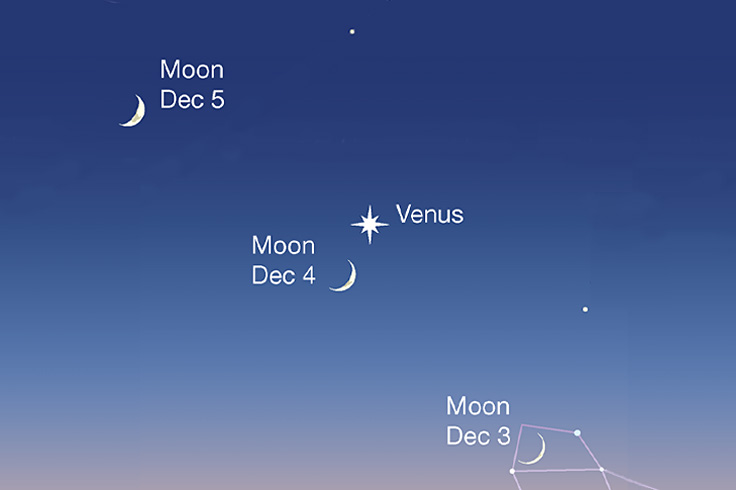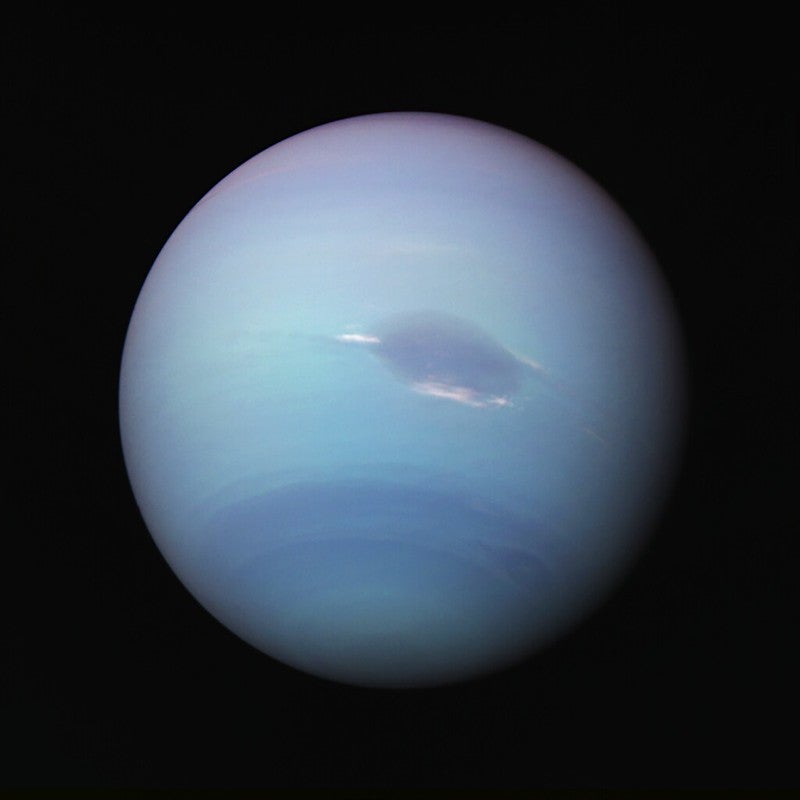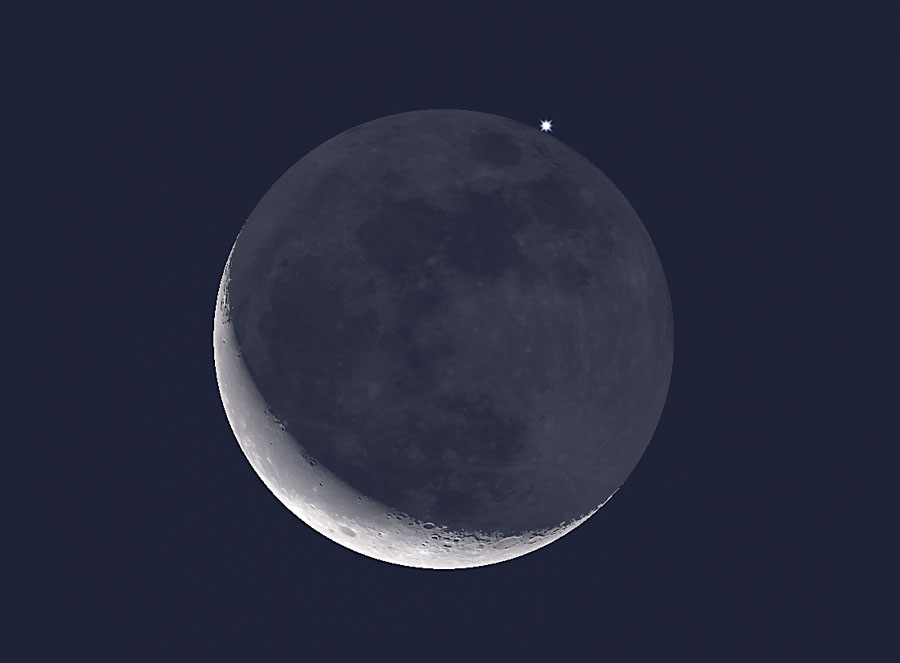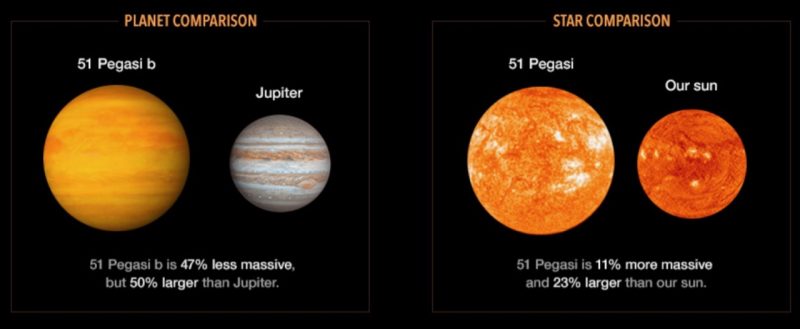*
FRIDAY, NOVEMBER 29
■ Thanksgiving has passed. So as soon as the stars come out, the Cassiopeia W stands on end (its fainter end) high in the northeast. Watch Cas turn around to become a flattened M, even higher in the north, by late evening.
SATURDAY, NOVEMBER 30
■ Vega still shines brightly well up in the west-northwest after dark. The brightest star above it is Deneb, the head of the big Northern Cross formed by the brightest stars of Cygnus. At nightfall the shaft of the cross extends lower left from Deneb. By about 11 p.m., it stands more or less upright on the northwest horizon.
SUNDAY, DECEMBER 1
■ Telescope users can watch the tiny black shadow of Jupiter’s moon Io start to cross Jupiter’s face at 9:02 p.m. EST (it enters on the planet’s eastern edge), closely followed by Io itself just 10 minutes later. They depart Jupiter’s opposite edge at 11:14 and 11:23 p.m. EST, respectively. Convert to your own time zone. Meanwhile, Jupiter’s Great Red Spot will be out of sight on the planet’s far side.
■ New Moon (exact at 1:21 a.m. December 1st EST).
MONDAY, DECEMBER 2
■ Two faint fuzzies naked-eye. The Andromeda Galaxy (M31) and the Perseus Double Cluster are two of the most famous deep-sky objects. They’re both cataloged as 4th magnitude, and in a moderately good sky you can see each with the unaided eye. Binoculars make them easier. Did you know they’re only 22° apart? They’re very high toward the east early these evenings — to the right of Cassiopeia and closer below Cassiopeia, respectively. They’re nearly overhead later.
But they look rather different, the more so the darker your sky. See for yourself. You can find them with the all-sky constellation map in the center of the November or December Sky & Telescope.
TUESDAY, DECEMBER 3
■ As twilight fades, spot the crescent Moon, just under three days old for North America, about a fist at arm’s length lower right of Venus — as shown under December 4 below.
■ The Double Cluster may be Perseus’s most famous deep-sky object, but it’s neither the biggest nor the brightest! That distinction goes to the big Alpha Persei Association. Binoculars are the perfect instrument for this swarm of stars born in the same area around the same time. It’s called an “association” rather than a “cluster” because it’s not gravitationally bound; its stars will simply drift apart.
The Alpha Per Association appears about 3° long, the size of your thumbprint at arm’s length. That’s roughly half the width of a typical binocular’s field of view. Find it running toward celestial south-southeast from Perseus’s brightest star. Matt Wedel notes that its sheer size is what makes it so overlooked. Take a tour through it using his Binocular Highlight column and chart in the December Sky & Telescope, page 43.
WEDNESDAY, DECEMBER 4
■ Catch the Moon paired with Venus during twilight and for an hour or so after dark, as shown below. When seen from the Americas they’ll be just 2° or 3° apart.
Think photo opportunity. Zoom way in and frame the Moon and Venus with interesting foreground. Prop your phone up on something solid, or mount your camera on a tripod, to prevent wiggles during what may be a relatively long exposure.
THURSDAY, DECEMBER 5
■ Now the thickening crescent Moon hangs about 12° upper left of Venus, as shown above.
FRIDAY, DECEMBER 6
■ Orion comes into good view low in the east-southeast after dinnertime now. And that means Gemini is also coming up to its left (for the world’s mid-northern latitudes). The head stars of the Gemini twins, Castor and Pollux, are at the left end of the Gemini constellation — one over the other, with Castor on top. The stick figures of the Twins are lying on their sides, with their feet toward Orion.
■ This is also the time of year when M31, the Andromeda Galaxy, passes your zenith after dinnertime (if you live in the mid-northern latitudes). The exact time depends on your longitude. Binoculars will show M31 just off the knee of the Andromeda constellation’s stick figure; see the big evening constellation chart in the center of Sky & Telescope.
SATURDAY, DECEMBER 7
■ Saturn shines about 5° upper left of the Moon this evening, as shown below for North America. Although they may look like companions, Saturn is currently 3,900 times farther away. The Moon and Saturn are the nearest and farthest solar-system objects that are easily visible to the naked eye.

That star near the Moon on the 6th is Delta Capricorni, magnitude 2.8. (The Moon’s actual apparent position against its background will always depend a bit on your location.)
■ Jupiter is at opposition.
■ Earliest sunset of the year (if you’re near latitude 40° north). By the time of the solstice and longest night on December 21st, the Sun sets 3 minutes later than it does now. The latest sunrise doesn’t come until January 4th. These slight discrepancies arise from the tilt of Earth’s axis and the ellipticity of Earth’s orbit.
SUNDAY, DECEMBER 8
■ First-quarter Moon (exact at 10:27 a.m. EST on this date). The Moon shines upper left of Saturn this evening, as shown above.
■ After darkness is complete, can you make out the dim Circlet of Pisces less than a fist-width above the Moon? Its stars are only 4th and 5th magnitude. Cover the glary Moon with your finger to help them show.
Still too much light pollution? Try binoculars. The Circlet is 7° wide and 5° tall, slightly overspilling the field of view of typical binoculars. Sweep around just a little bit to pick up all seven of the Circlet’s stars.
The Circlet’s easternmost (leftmost) star is the carbon star TX Piscium. It’s strikingly redder than ordinary “red” stars, which look more like orange or yellow-orange. We see carbon-rich stars through C2 vapor in their atmospheres, which acts as a red filter.
■ At this time of year the Big Dipper lies shyly down lowest soon after dark, due north. It’s entirely below the north horizon if you’re as far south as Miami.
But by midnight the Dipper stands straight up on its handle in fine view in the northeast, while Cassiopeia has wheeled down to the northwest to stand nearly upright on the bright end of its W shape.
This Week’s Planet Roundup
Mercury is out of sight in inferior conjunction with the Sun.
Venus (magnitude –4.2, crossing the Capricornus-Sagittarius border), gleams in the southwest in evening twilight, higher every week. It remains up for nearly 1½ hours after dark.
Mars (about magnitude –0.6, in Cancer) rises in the east-northeast around 8 or 9 p.m. It still forms the right angle of a rough right triangle with Castor and Pollux above it and Procyon to its right. Mars is 50° east along the ecliptic from brighter Jupiter.
Mars shows best in a telescope when very high toward the southeast or south in the hours after midnight. It has enlarged to 12 arcseconds in apparent diameter. It’s on its way to a relatively distant opposition in mid-January, when it will reach a diameter of 14.5 arcseconds.
Jupiter is at opposition this week (exactly so on December 7th), shining at a bright magnitude –2.8 in Taurus. Spot it low in the east-northeast as twilight fades. As dusk deepens, watch for Aldebaran and slightly fainter El Nath (Beta Tauri) to come into view nearly equidistant to Jupiter’s right and left. Jupiter will lie exactly between the two stars on December 10th. Watch its progress with respect to them from night to night by holding a straightedge up to the row of three.
Jupiter is at its telescopic best when very high toward the south in the night’s middle hours. It’s 48 arcseconds wide in a telescope and will remain so for another couple weeks.

North is up. Go writes, “The GRS [Great Red Spot] has become very small! The shrink seems to have accelerated. Will the GRS disappear in our lifetime? This might be a possibility!
“The wake of the GRS [left of it here] is very active. Note the strange feature, a complex bright streak [spanning the disk] on the Equatorial Zone above the GRS. A lot of features are resolved toward the poles.”
Saturn, magnitude +1.0 in Aquarius, glows highest in the south soon after dark. Don’t confuse it with Fomalhaut twinkling two fists below it. Saturn is now 38° east of Venus along the ecliptic. Watch them close in on each other toward their conjunction on January 18th, when they’ll pass each other by 2.2°.

Uranus (magnitude 5.6, at the Taurus-Aries border) is in the east during evening, about 7° from the Pleiades. You’ll need a good finder chart to tell it from its surrounding faint stars. Charts are in the November Sky & Telescope, page 49.
Neptune (tougher at magnitude 7.9, near the Circlet of Pisces) is high in the south after dark, 14° east of Saturn. Again you’ll need a proper finder chart.
All descriptions that relate to your horizon — including the words up, down, right, and left — are written for the world’s mid-northern latitudes. Descriptions and graphics that also depend on longitude (mainly Moon positions) are for North America.
Eastern Standard Time (EST) is Universal Time minus 5 hours. UT is also known as UTC, GMT, or Z time.
Want to become a better astronomer? Learn your way around the constellations. They’re the key to locating everything fainter and deeper to hunt with binoculars or a telescope.
This is an outdoor nature hobby. For a more detailed constellation guide covering the whole evening sky, use the big monthly map in the center of each issue of Sky & Telescope, the essential magazine of astronomy.
Once you get a telescope, to put it to good use you’ll need a much more detailed, large-scale sky atlas (set of charts). The basic standard is the Pocket Sky Atlas, in either the original or Jumbo Edition. Both show all 30,000 stars to magnitude 7.6, and 1,500 deep-sky targets — star clusters, nebulae, and galaxies — to search out among them.

Next up is the larger and deeper Sky Atlas 2000.0, plotting stars to magnitude 8.5; nearly three times as many, as well as many more deep-sky objects. It’s currently out of print, but maybe you can find one used.
The next up, once you know your way around well, are the even larger Interstellarum atlas (201,000+ stars to magnitude 9.5, and 14,000 deep-sky objects selected to be detectable by eye in large amateur telescopes), andUranometria 2000.0 (332,000 stars to mag 9.75, and 10,300 deep-sky objects). And read How to Use a Star Chart with a Telescope. It applies just as much to charts on your phone or tablet as to charts on paper.
You’ll also want a good deep-sky guidebook. A beloved old classic is the three-volume Burnham’s Celestial Handbook. An impressive more modern one is the big Night Sky Observer’s Guide set (2+ volumes) by Kepple and Sanner. The pinnacle for total astro-geeks is the new Annals of the Deep Sky series, currently at 11 volumes as it works its way forward through the constellations alphabetically. So far it’s up to H.
Can computerized telescopes replace charts? Not for beginners I don’t think, and not for scopes on mounts and tripods that are less than top-quality mechanically. Unless, that is, you prefer spending your time getting finicky technology to work rather than learning how to explore the sky. As Terence Dickinson and Alan Dyer say in their Backyard Astronomer’s Guide, “A full appreciation of the universe cannot come without developing the skills to find things in the sky and understanding how the sky works. This knowledge comes only by spending time under the stars with star maps in hand and a curious mind.” Without these, “the sky never becomes a friendly place.”
If you do get a computerized scope, make sure that its drives can be disengaged so you can swing it around and point it readily by hand when you want to, rather than only slowly by the electric motors (which eat batteries).
However, finding faint telescopic objects the old-fashioned way with charts isn’t simple either. Do learn the essential tricks at How to Use a Star Chart with a Telescope.
![]() Audio sky tour. Out under the evening sky with your
Audio sky tour. Out under the evening sky with your
earbuds in place, listen to Kelly Beatty’s monthly
podcast tour of the naked-eye heavens above. It’s free.
“The dangers of not thinking clearly are much greater now than ever before. It’s not that there’s something new in our way of thinking, it’s that credulous and confused thinking can be much more lethal in ways it was never before.”
— Carl Sagan, 1996
“Facts are stubborn things.”
— John Adams, 1770




